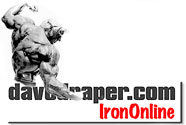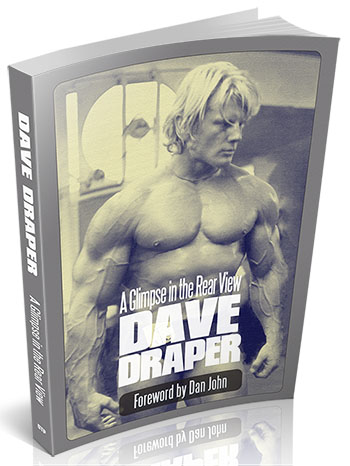Repel the Slug of Monotony

This photo is available for sale as an 8x10, click here for details
Download the full Draper here newsletter
in printable, live-link, pdf format, here.
I carry in my quiver a selection of pointed arrows to slay the wretched little beast of muscle obstinacy and repel the slow crawling slug of monotony. Unchecked, these miserable creatures will take down and drag away, if only for a short time, the hardiest of iron warriors. Those of less mettle will be disposed of entirely.
Over the decades I’ve dealt with the enemy, and still today I allow him no room to move or wedge or pry, no place to bristle or gnaw. Beware. Deal the first blow and survive; nay, deal the first blow and conquer. Without fighting the battle is never won.
There’s an inertia common on Tuesdays, the day after Monday yet three days before Friday. The weights can take on a blackness and a coldness that appears to add considerably to their density and unattractiveness. I stood stoop-shouldered before my carefully chosen bench and studied the abstract cracks in the aging gray Naugahyde.
My gaze drifted to the open back doors, which displayed an equally provoking scene. These are disturbing symptoms, Bomber. My mouth felt as if it were half full of flaxseed oil as I imagined myself lying on the bench with a pair of gravity-bound dumbbells over my head. Numbness, shallow breathing... Don’t lose it, dd.
Less than 30 seconds into this farce, this puny subjugation, a short-lived coup, a mere matter over mind, and an alertness came over me like a thrill. Lightning and thunder. I reached for my quiver and stroked its contents with sureness and pleasure. Like Prince Valiant I chose a well-honed arrow. Time to deal the first blow.
THE ARROWS
Lying lateral raise... to the front
Lying lateral raise... to the rear
Standing steep DB incline alternate curls
One arm cable crossover
One arm low lat pull
Arrow One--a lying lateral raise to isolate the deltoid caps as it draws upon the surrounding attached muscle groups to spread its good work through the entire upper body. Lie sideways on a bench with your shoulder to the vinyl and the opposing shoulder directly overhead. Allow the arm closest to the bench to extend comfortably forward and out of the line of action, while your leg likewise seeks its own comfort. The upper leg is extended 45 degrees forward, reaches to the floor and acts as the stabilizer.
A dumbbell of light weight, 5-15 pounds, is extended above your body to a neutral starting position. Slowly lower the weight forward to the chest cage to an agreeable extension, almost as if reaching for the floor. With power and control, return it to the starting position. Repeat for a set of 8-10 reps, and conclude by putting the dumbbell to the floor and rolling it under the bench to the other side. Flip your body position and repeat. Three or four sets of 12, 10, 8, 6 reps at the end of your delt routine is a treat.
Awkward at first, this body mover as it is practiced and perfected targets the front and side delts. Yet full range of motion, focus and elaboration will bring in a long lat sweep, mucho back stuff and rear deltoid contraction. A persuasive body thrust with heavier weight involves and exhausts the larger system of integrated muscles. It can get mean.
Its mate, the lying lateral to behind the torso, requires similar limb stabilizing. The shift of muscle action continues to bash the delts. These moves require a bit of unhurried investigative trial and error, a willing mind familiar with the learning process and the characteristics of finese. They will work for you if you work for them. Toughen, pack and etch.
Sets of these crazy spider lateral raises are done non-stop. Obviously this is no typical Bomber SuperSet.
Third arrow--injuries cause you to try different exercise positions. A bruised shoulder prevented me from effectively doing seated dumbbell 60-degree incline curls. Seeking an option I stumbled across a mighty, somewhat isolated biceps builder, a stray from the norm. At a 75-degree incline, I stood with my back against the pad of an adjustable bench. I bent at the knees slightly to gain a position of sturdiness, and let the dumbbells hang fully to my side. I engaged the weights one arm at a time and proceeded to do four sets of alternate curls.
Now you try. Dig in. 10, 8, 6, 6 reps fully extended, dig in, pull. Total attention on each arm, separate and alone, concentrate, back and forth…You got it!
I usually superset this with dips for tris to show my affection for the remaining upper body, the chest, back and shoulders. They like it.
Fourth, the one-arm cable crossover beats the dual-arm in that you can give superior focus to all ranges of pec activity, achieve a greater range of extension and contraction, work one pectoral group at a time with maximum output, and modify the action to incorporate surrounding, hungry muscle groups of the serratus, lats, bis.
Position yourself alongside your favorite cable apparatus as if you were about to perform a typical two-hand cable crossover. Crouch slightly in a position of readiness and with shoulders remaining in a straight line with cable system, draw the handle with a near-locked arm high across the pecs.
Back and forth, contract, extend, contract--look for rhythm, continuity, burn. As high-pec muscles fatigue after four reps, drop to a stronger mid-pec hand and cable groove 45 degrees toward the floor before you. Do another four reps and finish with a shift in your body to bring the cable directly down toward the floor as you locate low pec recruitment.
Have fun with this rangy exercise: improvise, feel, isolate, customize. Make it yours.
Back and forth, nonstop. No supersetting here, apply this combination to the end of your pec routine, 3-4 x 12. Form and burn is everything.
One-arm lat row--stand sideways, about three feet from the base of a low pulley system, handle in the hand farthest from the pulley. Assume a wide stance, bend at the knees and hips and let the weight stack extend to near touching. Your lats and arms should be in full extension, an appropriate starting position. Settle in, shift your footing for movement efficiency, hand on knee for support... ready, steadily pull handle to the mid-torso, contract, slowly return, stretch the low-lat insertions and repeat.
How you pull, to where you pull, the arch and contraction of your upper torso and the position of your body in relation to the cable system all determine what part of your musculature you will affect.
You put the paint on the canvas; you’re the artist.
Back and forth, nonstop. No supersetting here, apply this series to the end of your back routine, 3-5 sets, 12, 10, 8, 6 reps. Focus, trust yourself. It’s worth it.
Print these out. Read them over when the time and place is right.
Till later, dd.
-----
You don’t have to sign up for Facebook to read Dave’s commentary and interactions on his Facebook page. Dave is on Facebook here:
http://www.facebook.com/bodybuilderdavedraper
Dave is on Twitter, here:
---
Take a trip over to our
Musclebuilding Q&A Blog
... where Dave allows us a peek into his email outbox.
Did you sign up for Dave's expanded email yet?
It's free, motivating and priceless!
We'll also send you a link to Dave's free
Body Revival Tips and Hints e-report with your confirmation notice.

